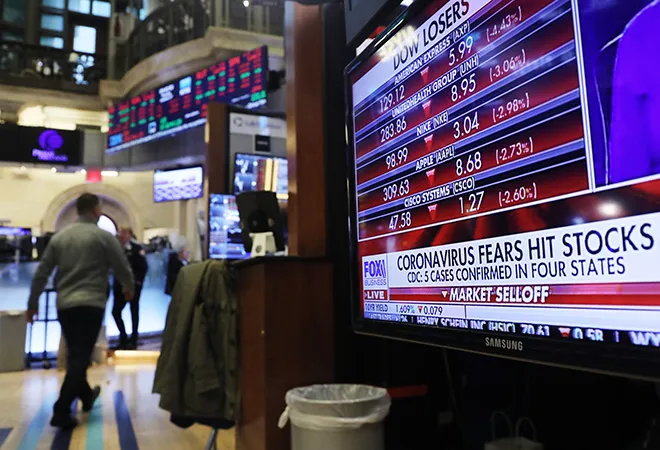
COVID-19 has had a deep impact on every aspect of our lives in India and the world. The anxiety, and the lurking fear in the subconscious reminds one of an eerie feeling experienced while viewing Alfred Hitchcock’s masterpiece — Birds, a 1963 film. The whole island of Bodega Bay was locked down with the fear of repeated bird attacks. The panic was everywhere. It had emptied roads, offices and radio stations, etc., and a fear of ‘who and what next’ had gripped the populace. Today it’s a virus and not birds. But the anxiety, fear and lockdown is quite similar. The biggest difference, of course, is the fear causing object in Hitchcock’s film were acting in local confines and not in an interconnected global world. The challenges today are, therefore, more profound. Movements of men, material and cargo have been completely paralysed in India and many parts of the world. A small segment of the services sector is trying to make up for the loss through “work from home” practices. The manufacturing, logistics, rest of the real economy as well as the services sector involving movements, are completely shut down, almost everywhere. No doubt, extraordinary situations require extraordinary action. However, it is important to understand what could be the impact of this dislocation on the economy of India and the world.
Economists have put out a grim forecast for the US economy. All projections are unified in their opinion of a sharp contraction in the second quarter, after a mild contraction in the first. The second quarter contraction is projected at 14 percent by JP Morgan, 12 percent by Bank of America and Oxford Economics, and a massive 24 and 30 percent respectively by Goldman Sachs and Morgan Stanley. The forecast of the first quarter contraction varies between 0.8 percent (Bank of America) and 4 percent (JP Morgan). A striking feature in all the studies is that the pessimism of the near-term, yields place to an optimistic growth outlook in the third and fourth quarters. The projections add up to a positive, though mild, growth for the US economy, for the year as a whole. The recovery is expected to be ‘V’-shaped, after the second quarter.
Extraordinary situations require extraordinary action.
OECD projects the world economy to grow at a slower rate of 1.5 percent during 2020, as against 2.9 percent projected earlier. No contraction is expected for the world economy, but a deep slowdown. OECD has further opined that “the economic fallout from the Coronavirus Pandemic will be felt far beyond the immediate impact of the virus.”
Impact on the Indian economy
It is difficult to forecast the impact on Indian economic growth in the next two quarters and beyond. Any such study would require data of intra as well as inter-country sectoral interdependence. The crisis today is no longer bilateral, as it was when it had affected China alone. CRISIL, had then carried out an impact analysis on certain important sectors of the Indian economy, which were dependent on Chinese trade. The crisis today has affected a large part of the world and disrupted trade flow all around. Further, the ongoing lockdown has severed all interdependencies in domestic sectors. In the absence of ready availability of such interdependency data, we propose to highlight factors, consequential to the lockdown, which are likely to influence/determine the course of the Indian economy, in the short- and medium-term.
Crisis of confidence
The principal data to carry out economic forecasting, is the underlying demand and supply conditions, as well as macro liquidity. The present crisis, characterised by widespread lockdown/closure of the economy over an unknown/indeterminate time period, has resulted in a ‘crisis of confidence’, which is the principal factor. This makes the current crisis distinct, in that it originates out of fear, anxiety and uncertainty, in contrast to all earlier ones, where demand/supply was the causal factor and confidence crisis was resultant.
With a decentralised production process, where component production in many cases is outside the mother unit, stoppage in supply of components can fracture the entire value chain.
Production and supply/distribution chain of goods have been disrupted on account of work stoppage and the ban on movements including withdrawal of logistics facilities, other than on essentials. The problem gets accentuated as the disruption is on account of a sovereign order, which can be reversed only by a superseding sovereign order. This will have to wait till the virus sends vibes of benign behaviour. The longer this disruption continues, deeper becomes the adverse impact and longer it takes the economy to swing back.
The list of sectors which has got affected on account of today’s extraordinary event, is exhaustive and includes both finished goods and components. With a decentralised production process, where component production in many cases is outside the mother unit, stoppage in supply of components can fracture the entire value chain. Disruptions of this type could also lead to delivery default for overseas supply contracts, with attended risk of blacklisting the firm in the international market, as well as invocation of penalty/warranty clause, unless the underlying contract provides for invocation of “force majeure” clause in such events.
The event has caused large job losses. The number of actual and potential job loss numbers are frightful, in the initial stage itself. Interestingly, the immediate impact is felt on travel and tourism, including hotels, and not on the manufacturing sector. Manufacturing sector will suffer its share of job losses with a lag due to protracted lockdown (if that happens), and the decline in demand on account of widespread closure and job losses in India’s large services sector.
India can perhaps expect an elongated ‘U-shaped’ recovery, and not a ‘V-shaped’ recovery as economists/investment bankers expect in the US.
As there has been no change in supply and/or demand fundamentals, the crisis and its potential enhancement has led to a lack of confidence not only in investment decisions, but also in day-to-day operations. The downturn will last till such time as an acceptable solution, or confidence building measures are found. As the events have disrupted the fundamentals of the economy, any adjustment/readjustment is likely to be long-drawn and can happen only with an elongated lag. This is reportedly being observed in China, where labour flow continues to be disrupted, as the returning labour is put through stringent test to avoid any recurrence of the disease. India can perhaps expect an elongated ‘U-shaped’ recovery, and not a ‘V-shaped’ recovery as economists/investment bankers expect in the US.
A back of the envelop calculation on the basis of GDP of USD 2.9 trillion (and complete lockdown, including essentials), suggests an approximate GDP loss of USD 8 billion per day. If the crisis and lockdown continue — hypothetically, for a month, the GDP loss thus suggests a GDP loss of around USD 240 billion, i.e. around INR 1.6 lakh crore.
Other dimensions of the crisis
The lockdown over a protracted period could lead to shortage in the economy with its attendant consequences. The lower level of economic activity and the lockdown could lead to closure of activity, especially in tiny businesses and weaker units. This presents a weak prognosis on the future asset quality of banks. We are probably staring at a spike in NPA numbers again, this time more widespread than earlier. This would have an adverse effect on credit flow and liquidity in the banking sector. The crisis is also reflected in the secondary capital markets (both debt and equity) worldwide, including India. Large losses are likely to deter investor appetite for quite some time. Credit Default Swap (CDS) spreads for Indian papers in the US market has already widened significantly, indicating an upward price pressure on new issuance, at a time when the domestic bank interest rate could go up and secondary market resources could become scarce. Urge to safety now drives investors towards US treasury and currency, resulting in strengthening of the USD vis-à-vis emerging market currencies.
Tackling the crisis
To overcome the crisis, central banks worldwide have made aggressive rate cut and infused liquidity. Though evaluation/conclusion on the efficacy of these policy measures, so early, would be hasty, available evidence do not indicate much success. It may be mentioned that liquidity enhancement through an external mechanism, like central bank intervention, is vitally necessary when internal dynamics are disrupted. Rate cut is, however, unlikely to remove the ‘crisis of confidence’ till the virus is put to rest. The monetary policy measures being pursued by the central banks do not appear to offer a comprehensive solution either.
Considering that the crisis is a fallout of an unknown virus, an effective policy measure, in our view, is to increase spending on medical and health programmes, which would be directed not just at innovative cure (vaccine discovery), but also a widespread mission to increase testing centres (capacity) and quality so as to identify the infected early, and take quick remedial action. That could indeed be a confidence booster. Meanwhile, a well-thought-out programme for restoration of the supply chain, albeit in a limited manner, may also be thought of.
The views expressed above belong to the author(s). ORF research and analyses now available on Telegram! Click here to access our curated content — blogs, longforms and interviews.




 PREV
PREV


